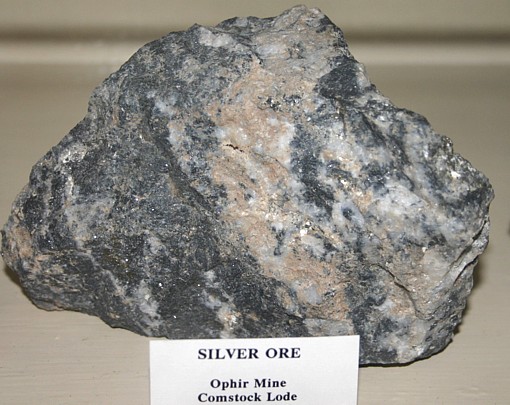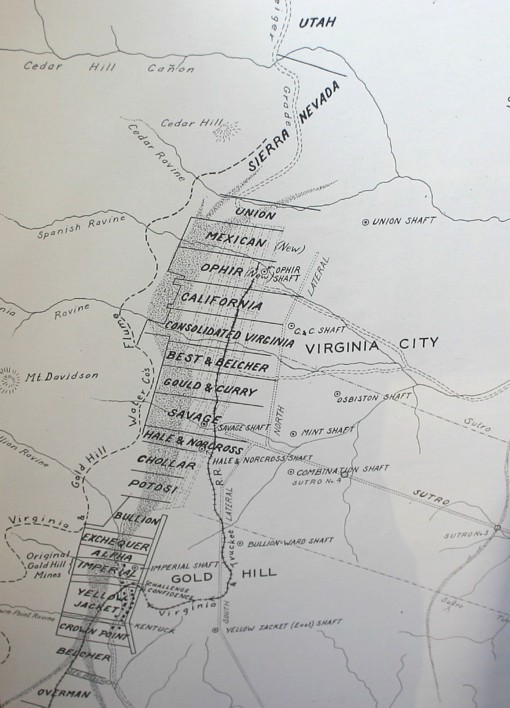In the spring of 1859, a considerable number of miners returned to Six-Mile Canyon, to work. They now made their headquarters at Gold Hill, where two or three log-houses including a large log boarding-house, had been erected. Peter O'Riley and Pat McLaughlin set to work well up at the head of the ravine, where the ground began to rise toward the mountain. They used rockers and found small pay. They continued to work at this point until about the ist of June, 1859, gradually extending their operations up the slope of the hill, in the hope of finding something better. They had started a little cut or trench up the hill and were washing the dirt taken from this in their rockers. Before they started the cut they were making only from $1.50 to $2 per day; in the cut their pay was even less. They were becoming discouraged, and were thinking of going to Walker River to try their luck, placer-mines having been found in that region the year before, but concluded to work on where they were a few days longer -probably in the hope of being able to raise money with which to go to Walker River. Having but a small stream of water, it became necessary for them to dig a hole as a sort of reservoir, in which to collect it for use in their rockers.
They set to work a short distance above the little cut in which they were mining, to make the needed reservoir or water-hole, and at a depth of about four feet, struck into a stratum of the rich decomposed ore of the Ophir Mine, and of the now world famous Comstock silver lode. The manner in which the grand discovery was made, was much less romantic than in the case of the discovery of the celebrated silver-mine of Potosi, Peru. What our miners found, was not glittering native silver, but a great bed of black sulfide of silver a decomposed ore of silver filled with spangles of native gold. This gold, however, was alloyed with silver to such an extent that it was more the color of silver than of gold. The gold dug in the placer-mines of California, is worth from $16 to $19 per ounce, whereas, the gold taken from the croppings of the Comstock was worth no more than $11 or $12 per ounce. When the discoverers struck into the odd-looking, black dirt, they only thought that it was a sudden and rather singular change from the yellowish gravel and clay in which they had been digging.
As any change was welcome, the luck in which they had been working considered, they at once concluded to try some of the curious-looking stuff in their rockers. The result astounded ' them. Before, they had only been taking out a dollar or two per day, but now they found the bottoms of their rockers covered with gold as soon as a few buckets of the new dirt had been washed. They found that they were literally taking out gold by the pound. However, as the gold they were getting was much lighter in color and weight than any they had found below on the canyon, or even on the surface in their cut, they began to fear that all was not right. They thought that, after all, what they had found might be some sort of "bogus stuff" base metal of some new and strange kind. It is not strange that these impecunious miners, tinkering away there on the side of a lone, sage-covered mountain, with their rockers, should have felt a little alarmed on account of the great quantity of gold they were getting, as in a few weeks after the discovery had been made and the work had been advanced further into the croppings of the lode they were taking out gold at the rate of $1,000 per day.
This they were doing with the rockers. Taking the harder lumps left on the screens of the rockers, one man was able to pound out gold at the rate of $100 per day in a common hand-mortar. In the evening of the day on which the grand discovery was made by O Riley and Mc Laughlin, H. T. P. Comstock made his appearance upon the scene. " Old Pancake," who was then looking after his Gold Hill mines, which were beginning to yield largely, had strolled northward up the mountain, toward evening, in search of a mustang pony that he had out prospecting for a living among the hills. He had found his pony, had mounted him, and with his long legs dragging the tops of the sage-brush, came riding up just as the lucky miners were making the last clean-up of their rockers for the day. Comstock, who had a keen eye for all that was going on in the way of mining in any place he might visit, saw at a glance the unusual quantity of gold that was in sight. When the gold caught his eye, he was off the back of his pony in an instant. He was soon down in the thick of it all " hefting " and running his fingers through the gold, and picking into and probing the mass of strange-looking " stuff" exposed. Conceiving at once that a wonderful discovery of some kind had been made, Old Pancake straightened himself up, as he arose from a critical examination of the black mass in the cut, wherein he had observed the glittering spangles of gold, and coolly proceeded to inform the astonished miners that they were working on ground that belonged to him. He asserted that he had some time before taken up 160 acres of land at this point, for a ranch; also, that he owned the water they were using in mining, it being from the Caldwell spring, in what was afterwards known as Spanish Ravine.
Suspecting that they were working in a decomposed quartz vein, McLaughlin and O'Riley had written out and posted up a notice, calling for a claim of 300 feet for each and a third claim for the discovery ; which extra claim they were entitled to under the mining laws. Having soon ascertained all this from the men before him, Comstock would have "none of it." He boisterously declared that they should not work there at all, unless they would agree to locate himself and his friend Manny (Emmanuel) Penrod in the claim. In case he and Penrod were given an interest, there should be no further trouble about the ground. After consulting together, the discoverers concluded that, rather than have a great row about the matter, they would put the names of Comstock and Penrod in their notice of location. This being arranged to his satisfaction, Comstock next demanded that 100 feet of ground on the lead should be segregated and given to Penrod and himself for the right to the water they were using he stoutly asserting that he not only owned the land, but also the water, and, as they had recognized his right to the land, they could not consistently ignore his claim to the water flowing upon it.
In short, he talked so loudly and so much about his water-right that he at last got the 100 feet, segregated, as he demanded. This 100 feet afterwards became the Spanish or Mexican mine, and yielded millions of dollars. Comstock would probably not so easily have obtained what he demanded, had the men who made the discovery been fully aware of its great value. They, however, did not know that the "blue stuff" (sulfide of silver), which they had dug into, was of any value, and even the gold itself seemed altogether too plentiful as well as a good deal " off color." Comstock had probably at some time posted up a notice claiming 160 acres of land, somewhere in that neighborhood, as a ranch, but if he did so he never had his notice recorded. Men in those days, while roving about the country, very frequently wrote out and stuck up notices claiming land, springs, the water of. streams, quartz veins, gravel deposits, or anything else that they might for the moment think valuable, but unless such claims were properly recorded and worked they could not be held, as all miners and others well knew a mere notice expiring at the end of ten days, when the property might be taken up, recorded and held by the first man that came along.
Comstock had some show of right to the water and to the placer-mines along the upper part of Six-mile Canyon, as the year before, he, Old Virginia and Penrod, had bought of old Joe Caldwell a set of sluiceboxes and the water of a spring. However, the possession of a set of sluices on the canyon and a right to use water from a certain spring in the neighborhood, by no means gave Comstock or his friends the right to lay claim to a vein of quartz found in a hill somewhere in their section of the country. John Bishop, who bought Old Virginia's interest in the sluices, gravel-diggings and water, got no share of the quartz vein discovered by Pete O'Riley and Pat McLaughlin, though he managed to get in on the lead, locating the mine known as the Central No. 1; now a part of the California, one of the bonanza mines with millions of ore in sight. Bishop put up the first arastra ever built on the lead, starting it up two or three days before that of the Ophir folks began running.
He sold his interest in the Central No. 1. for $4,000 and shortly afterwards the purchasers sold the same ground for $1,800 per foot now (as incorporated in the California mine) the ground is selling at over $50,000 per foot, and John Bishop worked for decades, as a miner, at Gold Hill. After Comstock had managed to become largely interested in the new discovery, and after the gold taken out by O'Riley and McLaughlin had been carried down to Gold Hill and exhibited and examined, there was at once a great local excitement in regard to the new diggings, and all were anxious to get an interest in the claim, or on the lead as near to the original discovery as possible. Those who were finally recorded in the Ophir notice as original locators were the following persons: Peter O'Riley, Patrick McLaughlin, H. T. P. Comstock, E. Penrod, and J. A. ("Kentuck") Osborne. The men named had one-sixth each of 1,400 feet of ground on the lead and, in addition, Comstock and Penrod had 100 feet segregated to them, making 1,500 feet taken up by the party. The 100 feet of Comstock and Penrod, though in the midst of the 1,400 feet of ground, was not reckoned as a part of the Ophir claim and was soon sold and worked as a separate mine, under the name of the Mexican or Spanish mine. The Ophir claim was the first that was located, as a quartz claim, at any point on the Comstock lode, though as early as February 22nd., 1858, Old Virginia made a location on a large vein lying to the westward of the Comstock. This vein is known as the Virginia lead or Virginia croppings. It has never yielded much ore, but contains vast quantities of base metal of various kinds.
Return
to The Nevada Mining Rush Page:
Nevada Gold Rush Mining History


